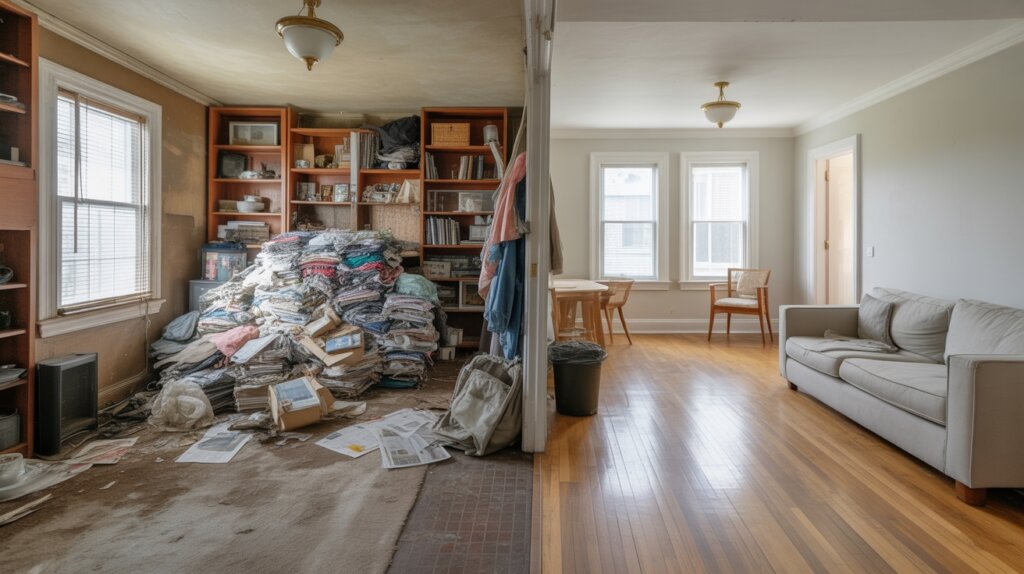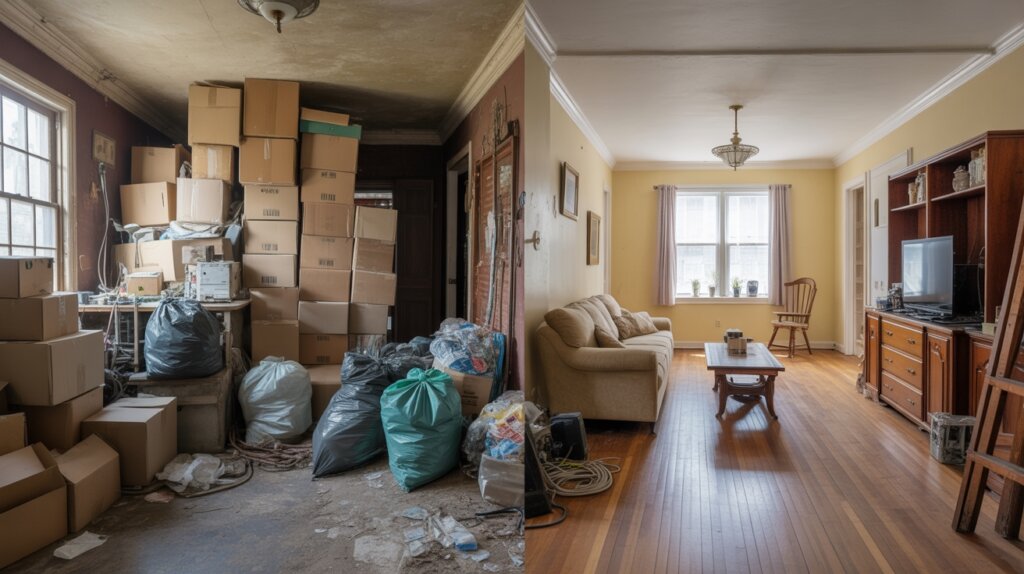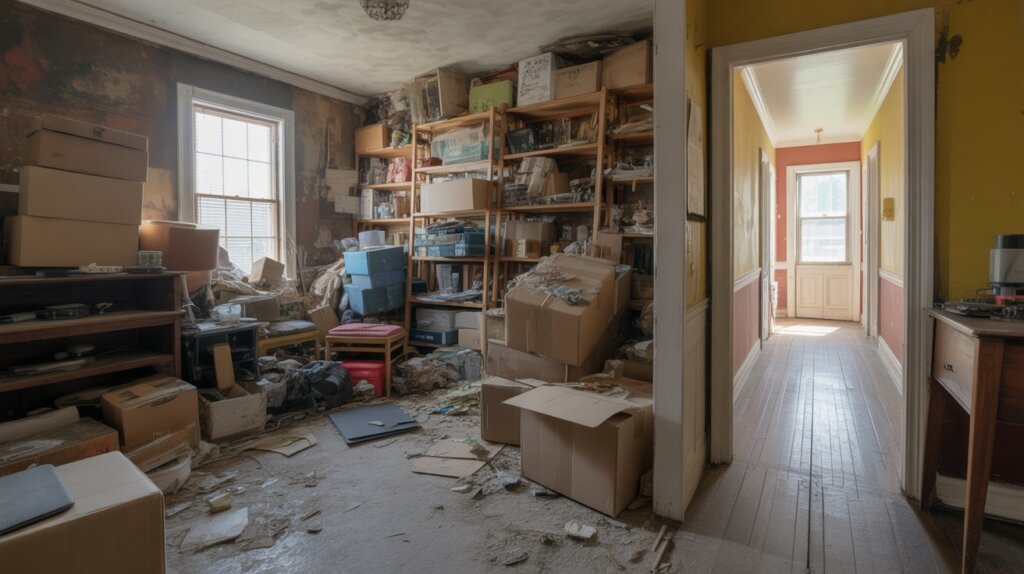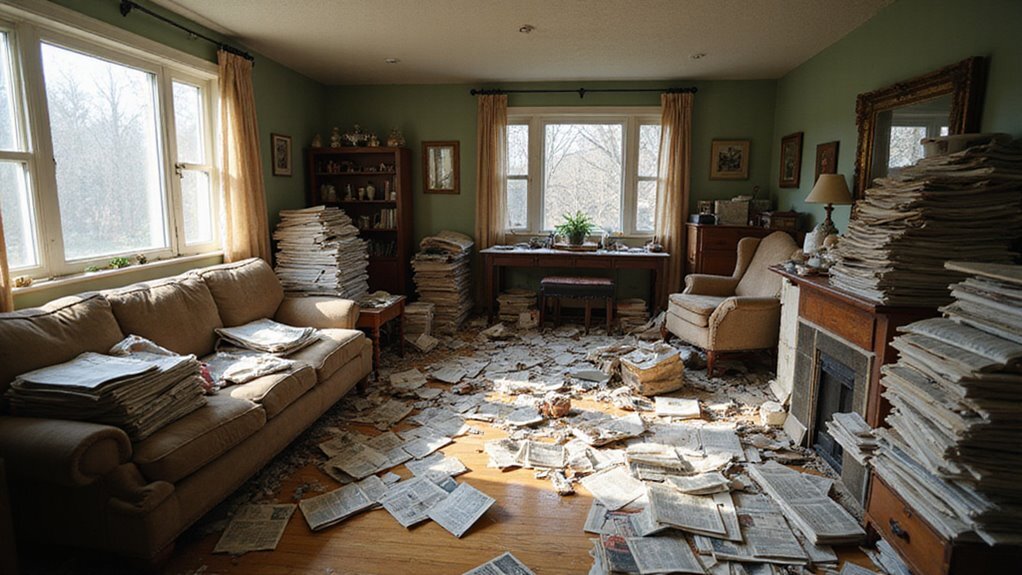Selling a hoarder house can feel overwhelming. You must choose between selling it as-is or making repairs before listing. This decision affects how quickly you sell and how much money you make.
The mess and damage can scare away buyers. Cleaning or fixing everything takes time, money, and energy. Ignoring repairs might lower offers, but fixing too much could drain your resources.
The best way to sell a hoarder house depends on your goals, budget, and how fast you want to close. This blog will guide you through each option, so you can confidently decide what works for you.
Key Takeaways
- Selling as-is offers a faster, simpler sale but usually attracts lower offers from investors or cash buyers.
- Making repairs increases buyer interest, can raise the sale price, and leads to a broader pool of potential buyers.
- Accurate repair and clean-up cost estimates help determine if fixing issues will provide a return on investment.
- Full disclosure of hoarder-related damage and hazards is legally required, regardless of selling as-is or after repairs.
- Market conditions and after-repair value should guide whether to invest in repairs or sell the house in its current state.
Understanding What Qualifies as a Hoarder House

A hoarder house is a home where too many items make rooms hard to use or unsafe. Hoarding goes beyond normal clutter and can stop people from living safely. If you see blocked walkways and rooms filled with things, it may be a hoarder house. Recognizing the signs early can help address downsizing benefits before safety issues worsen.
The International OCD Foundation says 2% to 6% of people have hoarding disorder. These homes can have fire hazards, mold, and other safety problems. Regular cleaning and storage often do not work in these cases. If clutter keeps you from using your home, it could be more than simple disorganization. Hoarder houses often need specialized help to fix. Noticing these signs early can help prevent bigger problems.
Evaluating the Condition and Value of the Property
To know the real condition and value of a hoarder house, you need an inspection and appraisal. A home inspection will reveal hidden problems like mold, pests, or damage. These issues affect your price and repair decisions. Additionally, understanding any liens on the property is crucial, as they can impact the sale process and potential costs involved. An appraiser will compare your house to similar homes in the area.
The appraisal will adjust for the hoarded home’s unique condition. If the numbers are low, you might choose to sell as-is. If the inspection and appraisal show only minor issues, you could make repairs for a higher sale price. Conducting a market analysis helps you determine the best strategy based on current demand and comparable sales. Results from both reports help you pick the best selling strategy. Careful evaluation helps you avoid surprises during the sale.
Legal and Disclosure Requirements for Hoarder Homes

Legal and disclosure requirements are important when selling a hoarder home because they protect sellers from legal problems. Most states require sellers to share any major issues with buyers, such as damage or pests. If you hide problems, you could face lawsuits or fines. Disclosing all known problems protects sellers from legal trouble and is often required when selling a hoarder home.
Sellers must list all known issues, even if they sell the house as-is. Good records help avoid disputes later. Detailed documentation is always recommended. Proper documentation can also serve as a defense if disputes arise after the sale.
If you do not disclose hazards, buyers may take legal action. Courts can order sellers to pay damages or fix problems. Full honesty helps build trust and prevents extra costs.
Consult a real estate attorney if you have doubts about your state’s laws. An expert can guide you through the disclosure process. Proper advice ensures you meet all legal requirements and understand title issues that may affect the sale.
Pros and Cons of Selling As-Is
When you sell your hoarder house as-is, you can often close much faster—many as-is sales finalize in 30 days or less. However, you’ll have less room to negotiate price or terms, since buyers know they’re taking on repairs.
Understanding these trade-offs helps you set realistic expectations and choose the best approach for your situation. Additionally, selling as-is allows you to deal with minimal stress by avoiding the need for repairs, inspections, and staging.
Quick Sale Potential
Selling a hoarder house as-is can help you sell it quickly. Many buyers prefer fast closings and do not mind extra work. You do not need to spend time or money on cleaning or repairs.
If you sell as-is, you might attract mostly investors or buyers looking for a project. This limits your potential buyer pool. Some buyers may not want a home that needs a lot of work.
If the house stays messy, it could lower nearby home values. Neighbors may not like the look of an unclean property. Consider your timeline and how your choice may affect the neighborhood before deciding.
Reduced Negotiation Leverage
Selling a hoarder house gives buyers more power in negotiations. Buyers know they must buy the home as-is, so they expect a lower price. If issues appear in the inspection or appraisal, you will have little room to negotiate.
Inspections often find serious problems in hoarder homes. Appraisers may lower the home’s value after seeing its condition. Buyers may use these findings to demand a discount or other concessions.
You can help by setting a fair price that matches similar homes and recent sales. If you are honest about the home’s condition, buyers will trust you more. This approach can make negotiations smoother and keep the sale moving forward.
Pros and Cons of Making Repairs Before Listing

Making repairs before listing a hoarder house can help you attract more buyers. Repairs make the house look better and easier to sell. If you want to get the best price, fixing problems may be a good idea. Home repairs can help buyers see the home’s potential.
Staged and repaired homes often sell faster than those needing work. If you want a quick sale, repairs could be helpful. Fixing a hoarder house can take a lot of time and effort. Contractors may cause delays, and work can interrupt your plans. If repairs are expensive, you might not get all your money back. Evaluating condition of the home and understanding what repairs will provide the best return is essential before investing in extensive work.
If the market is slow, spending on repairs may not pay off. You should look at your goals and the local market before deciding. Only make repairs if the benefits clearly outweigh the costs. Considering the market analysis can help determine whether repairs will add sufficient value and appeal to potential buyers.
Estimating Repair and Clean-Up Costs
Estimating repair and clean-up costs helps you decide if repairs are worth the money. You first need to know the full cost of cleaning and fixing the home. A professional home inspection, costing $300–$500, finds hidden problems. Reliable cash buyers have the resources and expertise to assess property conditions quickly, which can be especially helpful in distressed situations.
Inspections can reveal structural issues, plumbing problems, or unsafe areas. Pest control is often needed in hoarder homes and may cost $200–$1,000, depending on the problem. Junk removal usually costs $500–$2,000, and deep cleaning can add $1,000–$3,000. If mold or biohazards are present, costs will be higher.
You should get bids from licensed contractors for the most accurate estimates. Knowing the extent of structural damage and other issues helps in planning repairs or deciding to sell as-is. If you know these costs, you can better decide to sell as-is or make repairs.
How Hoarder Houses Are Valued by Buyers
Buyers value hoarder houses based on their potential after cleaning and repairs. They do not focus on the home’s current messy state. Investors and buyers look at what the house could be worth once fixed. They check recent sales of similar homes in the neighborhood. Buyers subtract the estimated costs for cleaning and repairs from the possible value. If the hoarding caused damage, the home’s value can drop by 5–30%.
Property depreciation is a key factor in their calculations. Buyers also consider the after-repair value, which is the future value after renovations. Knowing these steps can help you set the right expectations when selling. Additionally, understanding the costs involved in repairs and upgrades can help sellers better evaluate their options. Recognizing the market value of similar properties can guide pricing strategies and negotiations.
Marketing Strategies for As-Is Sales
When selling a hoarder house as-is, you need marketing strategies that target investors and cash buyers. These buyers often look for properties below market value. If you focus on them, you will likely sell the house faster. Highlight the as-is condition in every listing and be honest about the property’s state. If you provide a home inspection report and appraisal upfront, you can set clear expectations.
This reduces the chances of long negotiations. Homes marketed with full disclosures often sell 25% faster, according to real estate data. You should use investor-focused platforms like Auction.com, Craigslist, and Facebook Marketplace. If you emphasize the property’s investment potential, serious buyers may make quick cash offers. Additionally, understanding the market value of the property can help you price it competitively and attract motivated buyers. Furthermore, understanding current market conditions—such as supply and demand—can influence how attractive your property appears to cash buyers and investors.
Marketing Strategies After Repairs Are Made
Once repairs are complete, you should spotlight upgraded features and use professional staging and photography to showcase the transformation. Data shows that staged homes sell 73% faster, so it’s smart to invest in visual appeal. Target motivated homebuyers by emphasizing move-in readiness and modern improvements in all your marketing materials.
Highlighting Upgraded Property Features
Upgraded property features make your home stand out in the market. Buyers notice recent improvements when deciding on an offer. Highlighting these features helps your home appraise well and pass inspections.
List upgrades in your marketing materials, such as descriptions and flyers. Focus on improvements that fix problems, increase efficiency, or modernize the space. If a home is move-in ready, buyers are more interested.
If you have new HVAC, plumbing, or electrical systems, mention them. These updates lower buyer worries and improve inspection results. Renovated kitchens or bathrooms also add value and attract more buyers.
Energy-efficient features, like new windows or better insulation, appeal to buyers wanting lower energy bills. If you installed these, make sure to mention them. Buyers often prefer homes that save money over time.
Professional Staging and Photography
Professional staging and photography help your home look its best to buyers. Staging shows each room’s purpose and makes spaces feel larger. Buyers can imagine themselves living in your home if it’s clean and well-organized.
The National Association of Realtors reports that 83% of buyers’ agents say staging makes homes easier to visualize. Staging both inside and outside your home can create a strong first impression. If you improve curb appeal by trimming the lawn or planting flowers, buyers may show more interest.
High-quality photos are very important for selling quickly and at a higher price. Homes with professional photos sell 32% faster and often for more money. Hiring a real estate photographer can highlight your home’s best features.
If you combine staging with professional photography, you attract more buyers. These steps can help you get the best possible sale price. Avoid using only smartphone pictures for your listing.
Targeting Motivated Homebuyers
You can attract buyers who are ready to act if you highlight your home’s move-in ready condition. Motivated homebuyers want properties they can occupy without delay. Clear marketing about your home’s readiness will draw these buyers.
If your house is decluttered and staged, mention these changes in every listing. Staging helps buyers see themselves living in the space. The National Association of Realtors says this leads to faster offers.
If you want to reach serious buyers, use targeted strategies. Show before-and-after photos to display improvements. Always mention recent repairs and upgrades for added appeal. If you follow these steps, your property will stand out to buyers eager for a quick purchase.
Working With Real Estate Agents Experienced in Distressed Properties
A real estate agent with experience in distressed properties can help you sell a hoarder house more easily. Such agents understand the challenges and know how to handle complex sales. They use proven methods to help you get the highest possible price. An experienced agent in distressed properties can simplify selling a hoarder house and help you achieve the best possible price.
If you work with an expert, your home may sell faster. The National Association of Realtors says homes sold by experienced agents sell 17% quicker on average. Agents can suggest ways to make your house look better, even if it is cluttered.
Professional photos are important because they attract more buyers online. If your agent arranges for skilled photography, your listing will get more attention. More showings usually lead to better offers.
Distressed property agents know local rules and what you must tell buyers. This knowledge helps protect you from legal problems during the sale. If you need repairs or cleanup, their contacts can save you time and money.
Attracting Cash Buyers and Investors
Cash buyers and investors target hoarder houses because they want to make a profit. They look for low prices, fast closings, and chances to improve the property. If you want to attract them, highlight these important points.
Sellers should share details about the property’s zoning and possible future uses. Investors want to know if they can build or develop in new ways. Zoning information may encourage more interest.
Be open about any estate taxes tied to the property. Honest details can make investors more comfortable with the transaction. If there are no tax issues, state this clearly.
List your property in places where investors look for distressed homes. Use investor groups and websites focused on cash buyers. Targeted marketing can help you reach the right audience.
Navigating Offers and Negotiations
When you receive cash offers, assess each one by comparing not just the price, but also the terms and contingencies involved. Data shows that strategic counteroffers can increase your final sale price by 3-5%. You’ll want to approach negotiations with clear goals and a willingness to utilize competing bids.
Evaluating Cash Buyer Offers
A strong cash offer is reliable and comes from a buyer who is ready to close quickly. A risky offer may fall through or cause delays. Sellers should look at more than just the price.
Buyers with verified proof of funds are more trustworthy. If a buyer cannot show financial documents, the offer may not be solid. Always ask for proof before accepting any offer.
Experienced buyers usually want a quick inspection. If the buyer delays, they may not be serious. Inspections also show if the buyer understands the house’s condition.
Title problems are common with hoarder houses. A good buyer has a plan to fix these issues. If a buyer cannot explain their process, you may face problems later.
Sellers should choose offers with transparency and clear communication. A prepared buyer will make the sale smoother. If you want to avoid delays, focus on these details.
Counteroffer Strategies Explained
Counteroffer strategies help you get a higher sale price during negotiations. Sellers who counter at least once often earn 3-5% more. You should use a clear plan when responding to buyers.
If your home has special features, mention them to increase its value. Examples include a hobby collection or vintage design. This makes your home stand out to buyers.
Be honest about the home’s as-is condition. Support your price by listing similar home sales. If the offer is low, reply quickly with your terms.
You can offer a faster closing or fewer repairs if needed. These steps show you are flexible but protect your price. A good counteroffer will move the negotiation forward and help you earn more.
Weighing Emotional and Practical Considerations
Selling a hoarder house brings both emotional and practical concerns. You may feel attached to the property, but selling as-is often saves time and stress. If you want a faster sale, selling as-is can help you avoid long delays.
If you can handle managing repairs, you might increase your home’s value. However, repairs require time, money, and energy. You should honestly think about your ability to take on extra work.
If letting go of the property helps your well-being, it may be best to sell quickly. Consider how much stress you can manage during the process. If you need to move forward soon, letting go of emotional ties may be necessary.
Timeline Expectations for Each Selling Approach
Selling a hoarder house as-is is usually much faster. Closings can happen in 7-21 days if you skip repairs. This works best if you need to sell quickly.
If you make repairs first, expect a longer timeline. Cleaning, fixing issues, and staging can take weeks or months. Contractor schedules and buyer interest may also cause delays.
Selling after repairs might get you a higher price. However, it requires more time and effort before you can list the home. Choose the approach that fits your needs and priorities.
Conclusion
If you are deciding how to sell a hoarder house, both as-is and repaired options have pros and cons. If you want a quicker sale, selling as-is may be best. If you can invest time and money, repairs could increase your profit.
If you choose to sell as-is, investors and cash buyers often respond quickly. If you make repairs, traditional buyers may offer higher prices. Your choice should depend on your goals, budget, and personal circumstances.
If you want to skip repairs and sell fast, we buy houses for cash. At Greg Buys Houses, we make the process simple and stress-free. Contact us today to see how we can help you sell your hoarder house.

